

What's the difference between the LM2576 and LM2596?
Catalog
What is the LM2576?What is the LM2596?LM2576 VS LM2596 PinoutLM2576 VS LM2596 Block DiagramLM2576 VS LM2596 FeaturesLM2576 vs LM2596: Alternatives and EquivalentsFrequently Asked Questions About LM2576 And LM2596ConclusionFAQs about LM2576 and LM2596Related ArticlesThe LM2576 and LM2596 are popular voltage regulators used in electronic circuits to convert varying DC input voltages into a stable DC output. These regulators are crucial in many electronic devices and systems because they provide reliable voltage control. Although both regulators perform similar functions, they have differences in their specifications, features, and operation. This article will explore and compare these differences in detail.
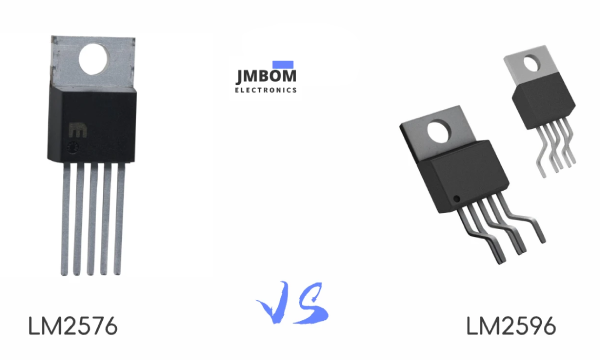
LM2576 vsLM2596
What is the LM2576?
The LM2576 series of monolithic integrated circuits incorporates all the essential functions of a step-down (buck) switching regulator. These regulators are available with fixed output voltages of 3.3 V, 5 V, and 12 V, while the adjustable version offers an output voltage range from 1.23 V to 37 V. Both variants can supply up to 3A of output current with excellent line and load regulation. Easy to operate, these regulators require minimal external components and feature built-in frequency compensation and a fixed-frequency oscillator. The LM2576 series provides a highly efficient alternative to traditional three-terminal linear regulators, significantly reducing the need for heat sinks and, in many cases, eliminating them altogether.
What is the LM2596?
The LM2596 family is a series of monolithic integrated circuits designed for step-down switching regulation. They can drive loads up to 3A with excellent line and load regulation. You can get these regulators in 3.3V, 5V, and 12V fixed output voltages, as well as adjustable versions. These regulators are simple to use, don't require many external parts, and include internal frequency compensation and a fixed frequency oscillator. The LM2596 series has a 150kHz switching frequency, which allows you to use lower frequency components and make the design easier by reducing the need for additional filtering. You can get these regulators in a standard 5-pin TO-220 package and a 5-pin TO-263 surface mount package, which gives you more flexibility in design and installation.
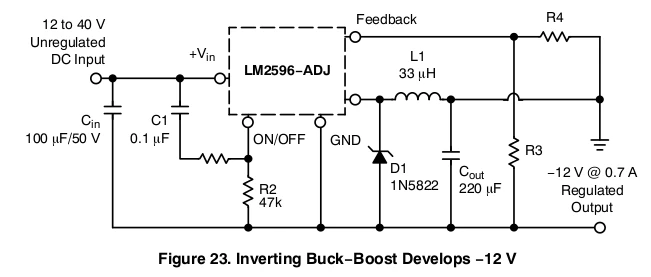
LM2576 VS LM2596 Pinout
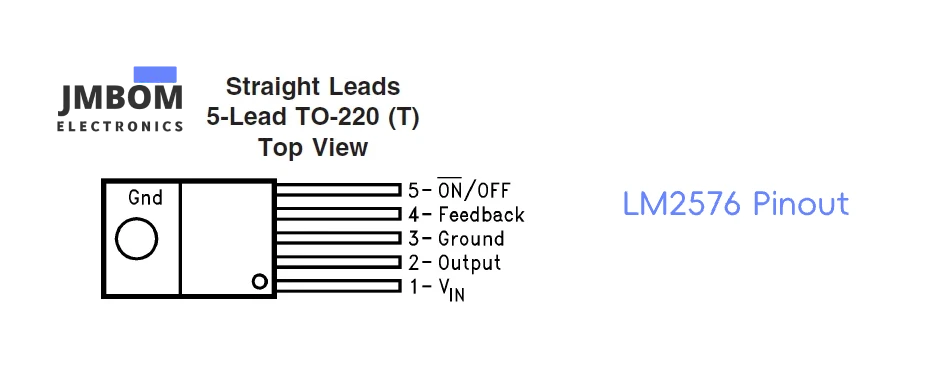
| Pin Number | Pin Name | Description |
| 1 | V IN | This pin is for regulated input voltage. |
| 2 | Output | The regulated output is available at this pin. |
| 3 | Ground | Connected to the system's ground. |
| 4 | Feedback | This pin gets the feedback voltage used to regulate the output. |
| 5 | ON/OFF | Connect to ground to enable the regulator, or to Vcc to disable it. |
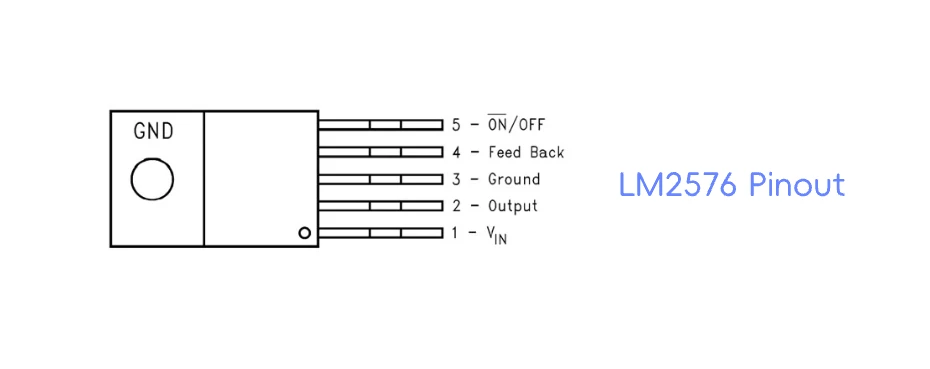
| Pin Number | Pin Name | Description |
| 1 | V IN | This pin serves as the positive input power for the IC switching regulator. It is essential to attach an appropriate input bypass capacitor to this pin to reduce voltage transients and provide the switching currents needed by the regulator. |
| 2 | Output | This pin functions as an internal switch, with its voltage toggling between roughly (+V IN - V SAT) and about -0.5V, while the duty cycle is V OUT / V IN. To reduce interference with sensitive circuits, the PCB copper area connected to this pin should be kept as small as possible. |
| 3 | Ground | Circuit ground |
| 4 | Feed Back | Monitors the regulated output voltage to complete the feedback loop. |
| 5 | ON/OFF | Enable pin; it should be connected to ground for normal operation. |
LM2576 VS LM2596 Block Diagram
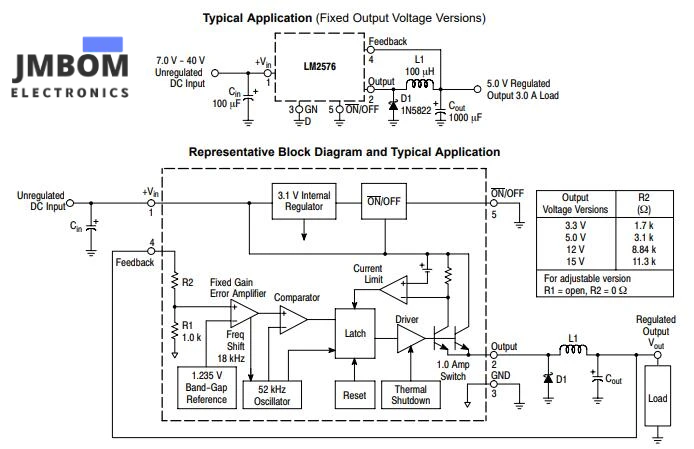
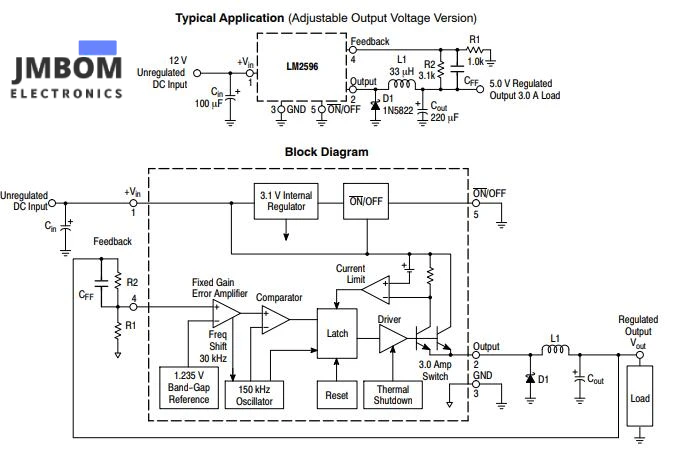
LM2576 VS LM2596 Features
Features of the LM2576 Voltage Regulator
- Incorporates an internal oscillator with a fixed frequency of 52kHz.
- Available in TO-220 and TO-263 packages.
- Provides fixed output voltages of 3.3V, 5V, 12V, and 15V.
- Includes built-in current limit protection and thermal shutdown features.
- With the addition of external components, the output voltage can be adjusted from 1.23V to 37V.
- Accepts input voltages up to 40 volts.
- When the input voltage is within the specified range and the oscillator frequency tolerance is ±10%, the regulator maintains an output voltage tolerance of ±4%.
- For adjustable versions, the output voltage range is 1.23V to 37V.
- The maximum output current is 3A.
- Features an undervoltage lockout circuit that keeps the regulator off until the input voltage exceeds a set threshold.
Features of the LM2596 Voltage Regulator
- Step-down voltage regulator IC capable of 3A output current
- Offers fixed voltage options of 3.3V, 5V, and 12V, as well as a variable regulator
- Supports a wide input voltage range from 4.5V to 40V
- Minimum output voltage is 3.16V
- Delivers a continuous output load current of 3A
- Capable of handling peak output currents up to 6.9A
- Operates with a switch frequency of 150 kHz
- Available in standard 5-pin TO-220 and TO-263 packages
LM2576 vs LM2596: Alternatives and Equivalents
LM2576 Alternatives:
- LM2677
- LM2575
- LM2576HVT-5.0
LM2596 Alternatives:
- XL6009
- TPS5430
- MC34063
LM2576 Equivalents:
- LM1117
- CS51411
- LM723
- LM7912
LM2596 Equivalents:
- LM2576
- BD9876
- ACT4523
Frequently Asked Questions About LM2576 And LM2596
What's the difference between LM2576 and LM2596?
The primary difference lies in their voltage regulation capabilities. The LM2576 is a fixed-voltage regulator, while the LM2596 can be used as both a step-down (buck) and step-up (boost) regulator. Additionally, the LM2596 typically supports a higher output current compared to the LM2576.
What are the common applications of LM2576 and LM2596?
Both the LM2576 and LM2596 are used in various electronic applications, including power supplies, battery chargers, LED drivers, automotive electronics, industrial automation, telecommunications, renewable energy systems, and testing setups.
Where can I find detailed information about LM2576 and LM2596?
Detailed information, including datasheets, application notes, and technical specifications for the LM2576 and LM2596, can be found on the Texas Instruments (TI) website. Additionally, electronic component distributors and technical resource websites provide comprehensive documentation and design resources for these devices.
Conclusion
Overall, the LM2576 and LM2596 are versatile voltage regulator ICs that are crucial in electronics. Whether used for powering devices, charging batteries, driving LEDs, or regulating voltages across various applications, these ICs are essential in advancing modern electronic systems and fostering technological innovation. Their simplicity, efficiency, and reliability make them indispensable tools for engineers, hobbyists, and electronics enthusiasts.
FAQs about LM2576 and LM2596
What is the current capacity of LM2596?
The LM2596 provides an adjustable output voltage range of 1.5V to 35V. It is rated to deliver 2A continuously, with a maximum output of 3A when used with an appropriate heatsink.
Do buck converters generate noise?
If not properly filtered, the input ripple and noise from a DC/DC converter can become significant enough to disrupt other devices sharing the same power source. Fortunately, several straightforward techniques can effectively minimize input noise and prevent interference with other systems.
What are the alternatives to LM2576?
Suitable replacements and equivalents for the LM2576 voltage regulator include CS51411, LM1117, LM7912, and LM723.
How do LM2576 and LM2596 differ?
The primary distinction between LM2576 and LM2596 lies in their voltage regulation capabilities. LM2576 functions as a voltage regulator, whereas LM2596 serves both as a voltage regulator and a boost converter. Additionally, LM2596 typically delivers a higher output current than LM2576.
What are the common applications of LM2576 and LM2596?
LM2576 is widely employed in various applications, such as power supplies, battery chargers, LED drivers, automotive systems, industrial automation, telecommunications, renewable energy systems, and testing equipment.
Where can I find detailed information about LM2576 and LM2596?
Comprehensive information, including datasheets, application notes, and technical specifications for LM2576 and LM2596, is available on the Texas Instruments (TI) website and through various electronic distributors and online platforms. These resources cover device specifications, recommended application circuits, design considerations, and performance characteristics in detail.
Click JMBom Electronics to learn more about electronics component.
Related Articles
LR44 VS SR44: Are LR44 and SR44 Interchangeable?
OPA2134 vs NE5532: Comparison of Performance, Features and Applications
Subscribe to JMBom Electronics !













